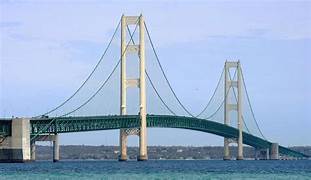In 1957, the United States witnessed the completion of a remarkable engineering feat that forever changed the landscape of transportation in the region. The Mackinac Bridge, connecting the state of Michigan's Upper and Lower Peninsulas, was officially opened on November 1, 1957. This iconic suspension bridge, spanning the Straits of Mackinac, quickly became a symbol of progress and a vital link for the people of Michigan. Prior to the construction of the Mackinac Bridge, travel between the Upper and Lower Peninsulas was arduous, often requiring lengthy ferry rides or a long detour around Lake Michigan. The need for a permanent and efficient connection had long been recognized, and plans for a bridge had been discussed for many years. Construction of the Mackinac Bridge began in 1954, and it was an ambitious project that posed numerous challenges. The Straits of Mackinac presented formidable natural obstacles, including strong currents, harsh weather conditions, and the need to maintain shipping lanes for commercial vessels. The bridge was designed as a suspension bridge, with a total length of approximately five miles. Its main span, measuring 3,800 feet, was one of the longest suspension bridge spans in the world at the time. The towers, standing at 552 feet above the water, were a remarkable engineering achievement. The construction process involved innovative techniques and extensive collaboration between engineers, construction workers, and various other experts. The bridge was built using prefabricated sections, which were lifted into place by cranes and then connected to form the continuous roadway. The teamwork and dedication of all involved ensured the successful completion of the project. The opening of the Mackinac Bridge on November 1, 1957, was a momentous occasion. Thousands of people gathered to witness the inaugural crossing of the bridge, which marked a significant milestone in the history of Michigan and the United States. The bridge's completion not only provided a crucial transportation link but also symbolized progress, unity, and economic growth for the region. The Mackinac Bridge quickly became an iconic landmark and a source of pride for the people of Michigan. It provided a safer and more efficient route for travelers, saving them time and money. The bridge also facilitated the movement of goods and services, boosting economic activity in the area and opening up new opportunities for commerce and tourism. Over the years, the Mackinac Bridge has played a vital role in connecting communities, fostering cultural exchange, and promoting regional development. It has become an enduring symbol of Michigan's natural beauty and engineering prowess, attracting millions of visitors each year who marvel at its grandeur and appreciate its historical significance. The Mackinac Bridge stands as a testament to human ingenuity and the power of infrastructure to transform lives and communities. Its construction and continued operation demonstrate the importance of visionary planning and the ability to overcome challenges through innovation and collaboration.
1957 U.S.A. – Mackinac Bridge
